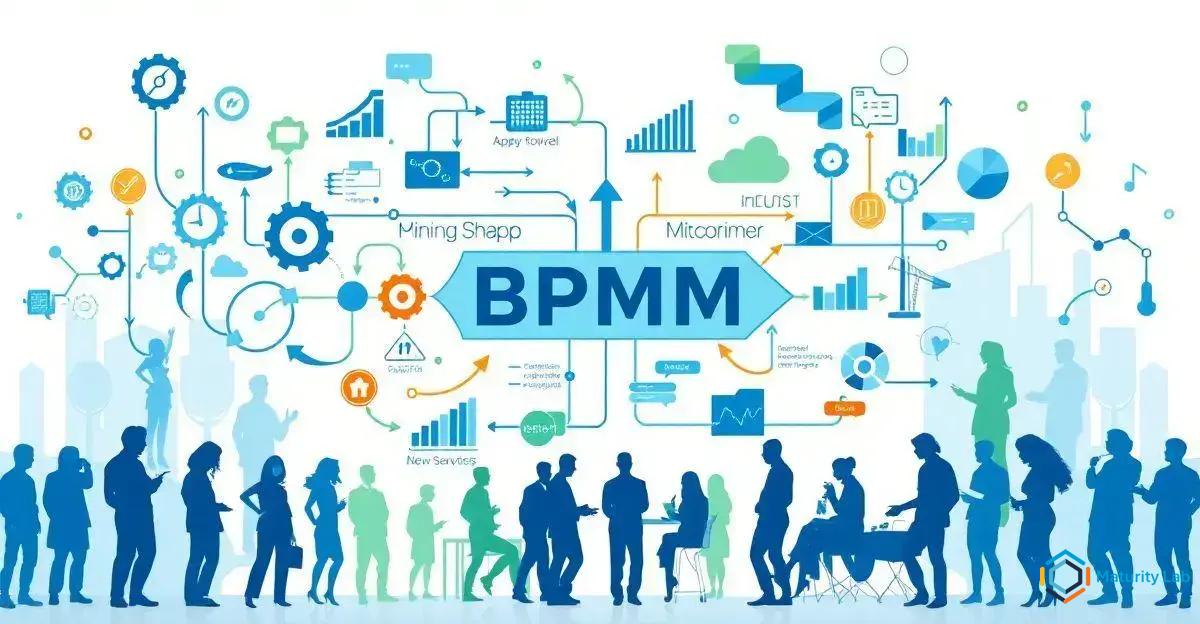The Business Process Maturity Model (BPMM) is a framework that helps organizations assess and improve their business processes through five maturity levels: Initial, Managed, Standardized, Predictable, and Innovating. By following BPMM, organizations can enhance efficiency, lower costs, and align processes with strategic goals, fostering a culture of continuous improvement and innovation.
In today’s competitive business environment, achieving strategic alignment is crucial for success. The Business Process Maturity Model (BPMM) offers a structured approach to enhance business processes and ensure they align with organizational goals. By understanding BPMM, companies can effectively streamline operations, improve efficiency, and drive strategic initiatives. This article explores the importance of BPMM, its role in enhancing business processes, and how it facilitates strategic alignment.
Understanding BPMM and Its Importance

The Business Process Maturity Model (BPMM) is a framework designed to evaluate and improve the maturity of an organization’s business processes. Originating from the Capability Maturity Model (CMM), BPMM provides a structured approach to assess the current state of processes and identify areas for improvement. Understanding BPMM is essential for organizations aiming to enhance efficiency, reduce costs, and achieve strategic goals.
BPMM is structured into five maturity levels: Initial, Managed, Standardized, Predictable, and Innovating. Each level represents a stage of process maturity, with specific characteristics and capabilities. At the Initial level, processes are typically ad hoc and chaotic, lacking standardization and predictability. As organizations progress through the levels, processes become more defined, managed, and optimized, leading to greater efficiency and effectiveness.
Benefits of BPMM
One of the key benefits of BPMM is its ability to provide a clear roadmap for process improvement. By identifying the current maturity level, organizations can develop targeted action plans to address weaknesses and build on strengths. This structured approach ensures that improvements are systematic and sustainable, rather than ad hoc and short-lived.
Moreover, BPMM facilitates benchmarking against industry standards and best practices. Organizations can compare their process maturity with peers and industry leaders, gaining insights into areas where they lag and opportunities for improvement. This benchmarking capability is invaluable for setting realistic goals and measuring progress over time.
Another important aspect of BPMM is its focus on continuous improvement. The model encourages organizations to regularly assess and refine their processes, fostering a culture of ongoing development and innovation. This continuous improvement mindset is crucial for maintaining competitiveness in a rapidly changing business environment.
In summary, understanding BPMM and its importance is fundamental for organizations seeking to enhance their business processes and achieve strategic alignment. By providing a structured framework for process assessment and improvement, BPMM helps organizations streamline operations, reduce costs, and drive strategic initiatives. Wouldn’t it be more efficient to implement an action plan to enhance your company’s maturity after understanding its current maturity level?
Enhancing Business Processes with BPMM

Enhancing business processes with the Business Process Maturity Model (BPMM) involves a systematic approach to identifying, analyzing, and improving organizational processes. The BPMM framework provides a clear pathway for organizations to elevate their process maturity, thereby achieving higher efficiency, quality, and strategic alignment.
The first step in enhancing business processes with BPMM is conducting a thorough assessment of the current process maturity level. This involves evaluating existing processes against the criteria defined in the BPMM framework, identifying gaps, and understanding the root causes of inefficiencies. This assessment provides a baseline from which organizations can develop targeted improvement plans.
Once the current maturity level is established, organizations can begin to implement changes aimed at moving to the next maturity level. For instance, if an organization is at the Initial level, efforts might focus on standardizing processes to ensure consistency and predictability. This could involve documenting processes, establishing standard operating procedures, and training employees on best practices.
Progressing Through Maturity Levels
As organizations progress to higher maturity levels, the focus shifts to optimizing and refining processes. At the Managed and Standardized levels, organizations work on process measurement and control, ensuring that processes are not only defined but also monitored and managed effectively. This might involve implementing process management tools, establishing performance metrics, and conducting regular process reviews.
At the Predictable and Innovating levels, organizations aim to achieve higher levels of process optimization and innovation. This involves leveraging advanced techniques such as process automation, data analytics, and continuous improvement methodologies like Six Sigma and Lean. By adopting these advanced practices, organizations can achieve significant improvements in process efficiency, quality, and agility.
Moreover, BPMM emphasizes the importance of aligning process improvements with strategic objectives. This ensures that process enhancements contribute to the overall goals of the organization, such as increasing customer satisfaction, reducing costs, or accelerating time-to-market. By aligning process improvements with strategic goals, organizations can achieve a greater return on investment and drive sustainable growth.
In conclusion, enhancing business processes with BPMM is a comprehensive approach that involves assessing current maturity levels, implementing targeted improvements, and aligning process enhancements with strategic objectives. By following the BPMM framework, organizations can systematically improve their processes, achieve higher efficiency and quality, and drive strategic alignment. Isn’t it time to take a structured approach to process improvement and unlock the full potential of your business processes?
Achieving Strategic Alignment through BPMM

Achieving strategic alignment through the Business Process Maturity Model (BPMM) is a multifaceted endeavor that ensures an organization’s processes are in harmony with its strategic goals. Strategic alignment is critical for maximizing organizational performance, as it ensures that every process, from operational tasks to strategic initiatives, contributes to the overarching objectives of the business.
The BPMM framework facilitates strategic alignment by providing a structured approach to process improvement. At its core, BPMM emphasizes the importance of aligning process maturity with strategic priorities. This alignment begins with a clear understanding of the organization’s strategic goals, which serve as the foundation for process assessment and improvement.
One of the primary ways BPMM achieves strategic alignment is through its focus on process standardization and optimization. By advancing through the maturity levels, organizations can ensure that their processes are not only efficient and effective but also aligned with strategic objectives. For example, at the Standardized level, processes are documented and consistently followed, which helps ensure that strategic initiatives are executed reliably and predictably.
As organizations progress to higher maturity levels, BPMM encourages the integration of strategic goals into process management practices.
At the Predictable level, processes are measured and controlled, allowing organizations to track their performance against strategic objectives. This measurement capability is crucial for ensuring that processes contribute to the desired outcomes, such as increased market share, improved customer satisfaction, or enhanced operational efficiency.
Furthermore, BPMM promotes a culture of continuous improvement, which is essential for maintaining strategic alignment in a dynamic business environment. By regularly assessing and refining processes, organizations can adapt to changing market conditions, emerging technologies, and evolving customer needs. This adaptability ensures that processes remain aligned with strategic goals, even as those goals evolve over time.
Another key aspect of achieving strategic alignment through BPMM is stakeholder engagement. BPMM encourages organizations to involve key stakeholders in the process improvement journey, ensuring that their insights and perspectives are considered. This collaborative approach helps align processes with the needs and expectations of stakeholders, including customers, employees, and partners.
In addition, BPMM provides a framework for benchmarking and best practice adoption. By comparing their process maturity with industry standards and best practices, organizations can identify areas for improvement and implement proven strategies to enhance their processes. This benchmarking capability ensures that process improvements are not only aligned with strategic goals but also reflect the latest industry trends and innovations.
In summary, achieving strategic alignment through BPMM involves a comprehensive approach that integrates process improvement with strategic priorities. By advancing through the maturity levels, measuring process performance, fostering continuous improvement, engaging stakeholders, and adopting best practices, organizations can ensure that their processes are aligned with their strategic goals. Isn’t it time to leverage BPMM to achieve strategic alignment and drive your organization’s success?
In conclusion, the Business Process Maturity Model (BPMM) offers a robust framework for organizations seeking to enhance their business processes and achieve strategic alignment.
By understanding BPMM and its importance, organizations can embark on a structured journey towards process maturity, characterized by increased efficiency, reduced costs, and improved strategic outcomes.
The process begins with a thorough assessment of current maturity levels, providing a baseline for targeted improvements.
As organizations implement changes and progress through the maturity levels, they can standardize, optimize, and innovate their processes, ensuring that these enhancements are aligned with strategic goals.
This alignment is crucial for achieving desired business outcomes, such as increased market share, enhanced customer satisfaction, and improved operational efficiency.
Continuous Improvement and Adaptability
Moreover, BPMM fosters a culture of continuous improvement, encouraging organizations to regularly assess and refine their processes.
This adaptability is essential in a rapidly changing business environment, allowing organizations to stay competitive and responsive to evolving market conditions and customer needs.
The involvement of key stakeholders and the adoption of industry best practices further ensure that process improvements are sustainable and aligned with strategic priorities.
Ultimately, BPMM provides a clear roadmap for organizations to achieve strategic alignment through process maturity.
By leveraging this framework, organizations can systematically improve their processes, drive strategic initiatives, and achieve long-term success.
Isn’t it time to adopt BPMM and unlock the full potential of your business processes to achieve strategic alignment and drive your organization’s success?
Frequently Asked Questions about BPMM, Business Processes, and Strategic Alignment
What is the Business Process Maturity Model (BPMM)?
The Business Process Maturity Model (BPMM) is a framework designed to evaluate and improve the maturity of an organization’s business processes. It provides a structured approach to assess the current state of processes and identify areas for improvement.
How does BPMM enhance business processes?
BPMM enhances business processes by providing a clear pathway for process improvement. It involves assessing current maturity levels, implementing targeted changes, and optimizing processes to achieve higher efficiency, quality, and strategic alignment.
What are the maturity levels in BPMM?
BPMM is structured into five maturity levels: Initial, Managed, Standardized, Predictable, and Innovating. Each level represents a stage of process maturity, with specific characteristics and capabilities.
How does BPMM facilitate strategic alignment?
BPMM facilitates strategic alignment by ensuring that process improvements are aligned with strategic goals. It involves integrating strategic objectives into process management practices, measuring process performance, and fostering continuous improvement.
Why is continuous improvement important in BPMM?
Continuous improvement is important in BPMM because it ensures that processes remain aligned with strategic goals in a dynamic business environment. Regular assessment and refinement of processes allow organizations to adapt to changing market conditions and evolving customer needs.
How can organizations benefit from benchmarking in BPMM?
Benchmarking in BPMM allows organizations to compare their process maturity with industry standards and best practices. This helps identify areas for improvement and implement proven strategies to enhance processes, ensuring alignment with strategic goals and industry trends.

